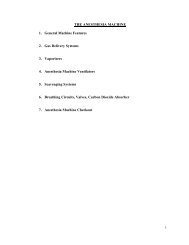BUMC Basics.pdf - Anesthesia Home
BUMC Basics.pdf - Anesthesia Home
BUMC Basics.pdf - Anesthesia Home
Create successful ePaper yourself
Turn your PDF publications into a flip-book with our unique Google optimized e-Paper software.
68<br />
- EEG silence x2 12 hours apart (pitfall – can be<br />
confounded with medications on board, also at high<br />
sensitivities, much artifact comes through)<br />
- Cerebral angiography-Gold standard (no flow-no<br />
brain. pitfall – costly, invasive, requires transporting<br />
patient out of ICU setting to radiology, not readily<br />
available)<br />
5. Southwest Organ Transplant can come and talk to the<br />
family about organ donation, but keep that separate<br />
from the talking you do with the family.<br />
NEUROMUSCULAR EMERGENCIES<br />
Some patients will present with generalized weakness with<br />
certain neurological conditions. This may result in bulbar<br />
(facial) or respiratory weakness, and require close monitoring.<br />
Patients with severe bulbar weakness are more likely to<br />
require mechanical ventilation.<br />
• The following conditions in particular should prompt<br />
special attention: Guillain-Barre, Myasthenia Gravis<br />
Exacerbation, Polymyositis<br />
• Watch FVC and Negative Inspiratory Force (NIF)<br />
frequently (approximately Q6 hours). NIF=Maximum<br />
Inspiratory Pressure (MIP). You can write an order in the<br />
chart to monitor NIF as above and this will be performed<br />
by respiratory therapy.<br />
• If FVC drops below 15 cc/kg, the patient will require<br />
intubation and ventilation.<br />
• NIF should be at least -25 cm H20. If NIF begins to<br />
become more positive, this may indicate worsening<br />
diaphragmatic weakness and require intubation.<br />
• Also severe facial/bulbar weakness may make<br />
performance of bedside spirometry difficult if not<br />
impossible. Patients should be able to take a deep breath<br />
and count out loud to at least 1 to 20 in a single breath. If<br />
the time period is shorter, the patient may need to be<br />
intubated.<br />
• Follow ABG and if PaCO2 if creeping up, then have a<br />
low threshold for intubation.




